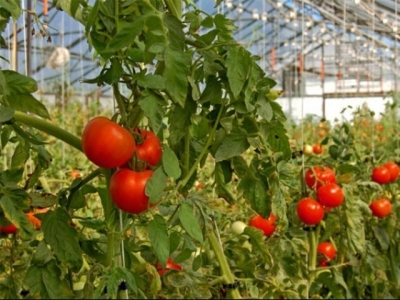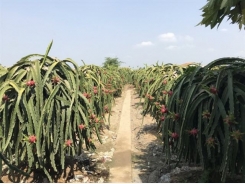Safe fruit & vegetables struggling to find favor

Producers of safe fruit and vegetables are still up against it in trying to eke out a respectable market share.
Photo from bmcgroup
Nearly 100 km from Hanoi, the safe tomato farm of the Green Technology JSC in Yen Khanh district, northern Ninh Binh province, regularly disposes of rotten tomatoes it has failed to sell. According to Chairwoman Ms. Le Thi Dung, the quantity of tomatoes produced often exceeds demand from distributors, with those being left over rotting after a few days. The issue not only faces Green Technology, as farmers in nearby Hai Duong province and Me Linh district in Hanoi also see large quantities of cauliflower and carrots go to waste, with oversupply also pushing prices down sharply.
Increasing numbers of Vietnamese people are now willing to buy safe organic food but supply and demand is significantly out of balance at times, creating serious challenges for enterprises involved in safe agriculture.
Ongoing difficulties
The greatest difficulty for Ms. Dung is sustainable consumption, as the prices of organic products are higher than traditionally-grown products. “The cost of growing VietGAP-standard vegetables is high because of the complex processes involved,” she explained. She spent a considerable sum purchasing large plots of fertile land and seedlings from the Vietnam National Seed JSC (Vinaseed) to ensure product quality, while the expensive fertilizers used during cultivation are micro-biological, which ensure there are no chemical substances in the product and no soil degradation.
Safe agricultural crops require much more human effort than regular crops and growing methods must be strictly adhered to, which pushes up labor costs. “I pay each of our 40 employees VND150,000 to VND200,000 ($6.60 to $8.80) per day, which is about 1.5 times higher than what other agricultural workers are paid,” she said. These factors result in prices for vegetables produced under VietGAP standards being double those of regular vegetables.
Technology transfer and traceability costs also affect prices. Ms. Pham Thuy Hao, Chairwoman of a safe vegetable hydroponic cooperative in northern Yen Bai province, said she outlaid VND1.5 billion ($66,000) to purchase hydroponic technology from the central highlands city of Da Lat and must also engage traceability authorities in Hanoi.
After all this, it’s proven difficult for customers to distinguish between safe and unsafe products, according to Mr. Nguyen Hong Lam, Chairman of the Que Lam Joint Stock Corporation, a producer of organic agricultural products and trader of fertilizers.
Apart from consumption issues, producers must also cope with a lack of capital. Ms. Dung is unable to take out loans because of the difficult appraisal process. In order to apply technology and meet VietGAP standards, farmers must invest in agricultural machinery but don’t have the financial wherewithal to do so. While the government has introduced solutions to support farmers in regard to capital, repaying loans can become problematic if prices fall significantly or if natural disasters strike.
Agricultural production enterprises, meanwhile, are locked in serious competition with Chinese imports at much cheaper prices than safe products from Vietnam, according to Ms. Tran Thi Thu Hang, Director of the Vietnamese Agricultural Product Import and Export JSC. Many vendors are therefore willing to import and distribute them around Vietnam. “Chinese potatoes, for example, are about VND4,000 ($0.17) per kilogram, while Vietnam’s are VND6,000 ($0.26),” she said.
While growing safe agricultural products is a difficult task, post-harvest preservation is even more difficult. Ms. Hang told VET that fresh vegetables can only be stored for two or three days. “If we can’t distribute our entire stock we have to throw a lot away because we can’t guarantee freshness,” she explained. “This is a waste for enterprises and for society.”
Entering the marketplace
Producers have been able to address many of the problems they’ve faced. There has been a lot of success in convincing customers about the quality of safe fruit and vegetables. “We had to offer a 50 per cent discount or two-for-one deals initially,” Ms. Hang said. “We needed to encourage customers to eat our vegetables and compare the quality,” Ms. Hang said. “This was useful and increased our customer numbers.”
Unlike Ms. Hang, Ms. Dung was able to find distributors for her safe tomatoes. Linking production chains for distribution and consumption, as Green Technology has done, better balances market demand, she said. Any such cooperation needs to be in place well before the harvest, which also brings peace of mind.
Along with a focus on producing quality vegetables, Ms. Dung also advertises her products at trade promotions and agriculture markets and expects to have standard packaging shortly, which opens up supermarket chains. She also organizes classes to train farmers about the differences in producing safe vegetables and regular vegetables.
With experience in the distribution of safe vegetables, Mr. Tran Quan, CEO of the Soi Bien safe food chain, said that safe products are finding favor among customers at its 20 outlets despite prices being 30 to 35 per cent higher. “Many South Korean businesses buy vegetables at Soi Bien outlets,” he said. “South Korean customers, who can be choosy, are also satisfied with our products,”. It uses three producers: Honest Farm, Thanh Xuan Organic Vegetable Farm, and the Vien Son Vegetable Farm.
Another distributor in Hanoi is 24h Safe Food, which generally distributes safe fruit and vegetables from nearby Hai Duong province. CEO Ms. Minh Thu said that producers are able to maintain stable product quality, though product appearance can differ. Full traceability of all products made it easier for it to convince customers about origin.
What’s needed
While they take steps to promote safe fruit and vegetables, producers also need support from the government. Ms. Dung believes that assistance to farmers in accessing capital at reasonable interest rates is one much-needed measure. Mr. Lam proposed that the government look at global trends and provide training to farmers and enterprises, while authorities should identify and punish counterfeiters and dishonest growers to ensure fair competition.
Ms. Hang suggested the government organize exchanges of experience between foreign and Vietnamese enterprises. “We visited clean vegetable farms in South Korea and looked at how they completed the entire process, from planting to harvesting and distribution,” she said.
Mr. Pham Dang Nam, Deputy Director of the Ninh Binh Provincial Department of Agriculture and Rural Development, believes that authorities should hold conferences and trade promotions to advertise safe products and arrange training programs on the latest technology from developed countries.
“Along with the strict supervision of the production process, production facilities need to identify measures to build trust among consumers about product quality. There also needs to be publicity about stores selling safe vegetables, so customers know where to buy them and begin the habit of eating healthily.”
Mr. Mac Quoc Anh, Vice Chairman and General Secretary, Hanoi Small and Medium Enterprises Association
Có thể bạn quan tâm
Phần mềm

Phối trộn thức ăn chăn nuôi

Pha dung dịch thủy canh

Định mức cho tôm ăn

Phối trộn phân bón NPK

Xác định tỷ lệ tôm sống

Chuyển đổi đơn vị phân bón

Xác định công suất sục khí

Chuyển đổi đơn vị tôm

Tính diện tích nhà kính

Tính thể tích ao hồ




 Vietnam’s Da Lat targets breakthrough in flower export
Vietnam’s Da Lat targets breakthrough in flower export  Healthy soils lift animal weights
Healthy soils lift animal weights